There have been several teams challenging at the top of the WSL this season for the top spot, with Manchester United Women and Everton Women joining Manchester City Women, Arsenal Women and Chelsea Women in the fight. The games between those sides have drawn much interest, with this round seeing Manchester City host Arsenal, and, with Manchester City unbeaten and Arsenal having lost only once so far this season, we were expecting a tight game with plenty of tactical switches during the game, as both sides looked to get the better of the other.
This tactical analysis will look at the tactics used by both sides in this game, with Arsenal opting for a high-pressing style of play, whilst Manchester City needed to make changes in the second half to take more control. We will also look at the role played by Scotland midfielder Caroline Weir for Manchester City, and how she was central to a lot of their good offensive play.
Lineups

Manchester City Women made five changes to the side that beat Everton Women in their last game, with defender Gemma Bonner, midfielder Jill Scott, and forwards Janine Beckie and Ellen White all moving to the bench, whilst USA international Rose Lavelle was left out of the squad altogether after suffering a knock against Everton and being withdrawn at half-time. Alex Greenwood started in central defence, having come on for Bonner against Everton, with Demi Stokes continuing at left-back. Sam Mewis replaced Scott in the midfield, whilst the forward line consisted of England internationals Lauren Hemp, Georgia Stanway and Chloe Kelly.
Arsenal Women named the same team that comfortably defeated Birmingham City Women last weekend. Australia goalkeeper Lydia Williams continued in goal, with regular stopper Manuela Zinsberger again on the bench. Club captain and Scotland midfielder Kim Little partnered Malin Gut in front of the defence, whilst Netherlands international Jill Roord was given the number 10 role, with Beth Mead and Caitlin Foord either side of her. Vivianne Miedema started upfront, completing a dangerous looking Arsenal attack.
Arsenal Women’s pressing tactics
We will first look at Arsenal Women’s pressing in the first half. This is something that we don’t see much of from them, but, against Manchester City Women, it helped them to take an early control in the game.

We will look at how the press worked in stages.
Firstly, here, we can see the way the defence sets up, stretching across the pitch and allowing the full-backs, Leonie Maier and Katie McCabe, to get high up the pitch and support the attack. By setting up in this way, Arsenal ensure that they control the wings and have constant passing options to get the ball too. If their opponents look to press one of the players, then the ball is simply moved to another area, and this makes it hard for their opponents to take the ball off them.
However, in the context of their attacking press, it means that the wider attackers, Mead and Foord, can cut inside much more and support Miedema, increasing Arsenal’s attacking presence. You can see in the image how Arsenal have all narrowed centrally, with Manchester City also coming inside as a result, hoping to stop them getting the ball in that area. The result of this is that Arsenal can then dominate the wings through their full-backs.

With more players able to come inside and support Miedema, the pressure they put on Manchester City allowed them to take an early lead. They constantly forced mistakes on the ball, and that is what has happened here, with Keira Walsh giving the ball away, and Miedema pouncing to give Arsenal the lead after only three minutes. We can see how Arsenal’s attacking presence increased the threat they posed, leading to the mistake and the goal.
From Manchester City’s point of view, we can see how they have looked to make the pitch as big as possible with their defensive structure, hoping to create passing options to move the ball out wide and then forwards towards the attack. However, in doing so, they have left gaps between each of the defenders, giving Miedema the space to shoot once she gets the ball from Walsh’s mistake.
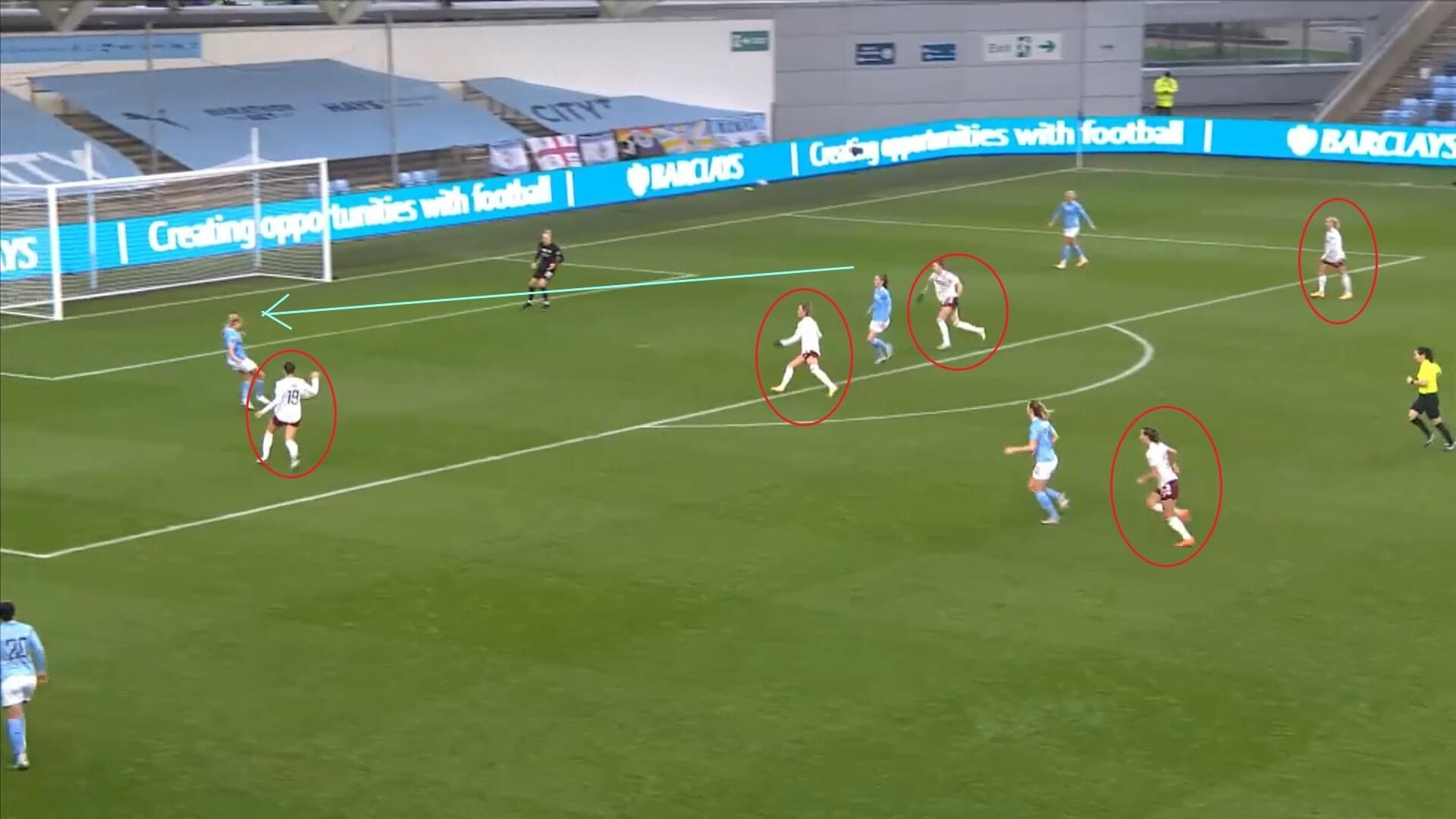
Arsenal’s pressing tactics became more notable as the game went on, and we can see here how, when one player went, they all went. This was what made this tactic so successful in helping them keep control of the game. Manchester City didn’t seem to know how to beat it, and, as a result, passed the ball backwards whenever Arsenal got into these positions, as the blue arrow demonstrates. However, this allowed Arsenal to press even further forwards, so it only increased the chances of Manchester City making a mistake and giving Arsenal a shooting opportunity in a good area.
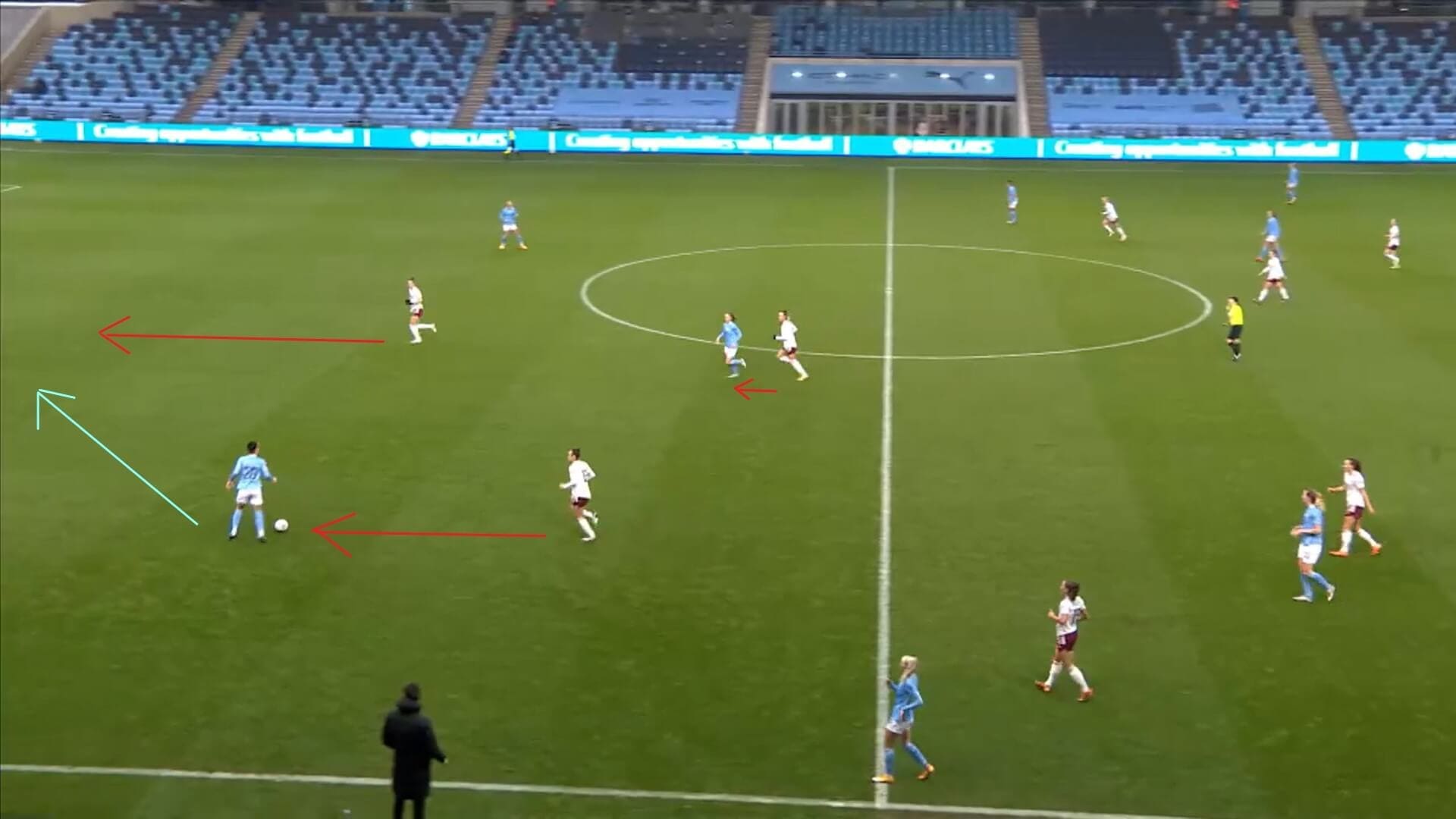
This image shows another instance of Arsenal pressing as a team. England right-back Lucy Bronze has the ball for Manchester City and is being closed down by Caitlin Foord. However, Bronze can’t move the ball to her teammate in the central areas, because she is also being pressed, so has to move the ball backwards, as the blue arrow indicates. As soon as the pass is made, Miedema moved forward to put pressure on the recipient of the ball. Therefore, whilst this time the press wasn’t made at the same time, but in response to where the ball went, the effect was still the same. Manchester City found it very difficult to find any spaces in their own third, and this was a key reason why Arsenal’s first half control.
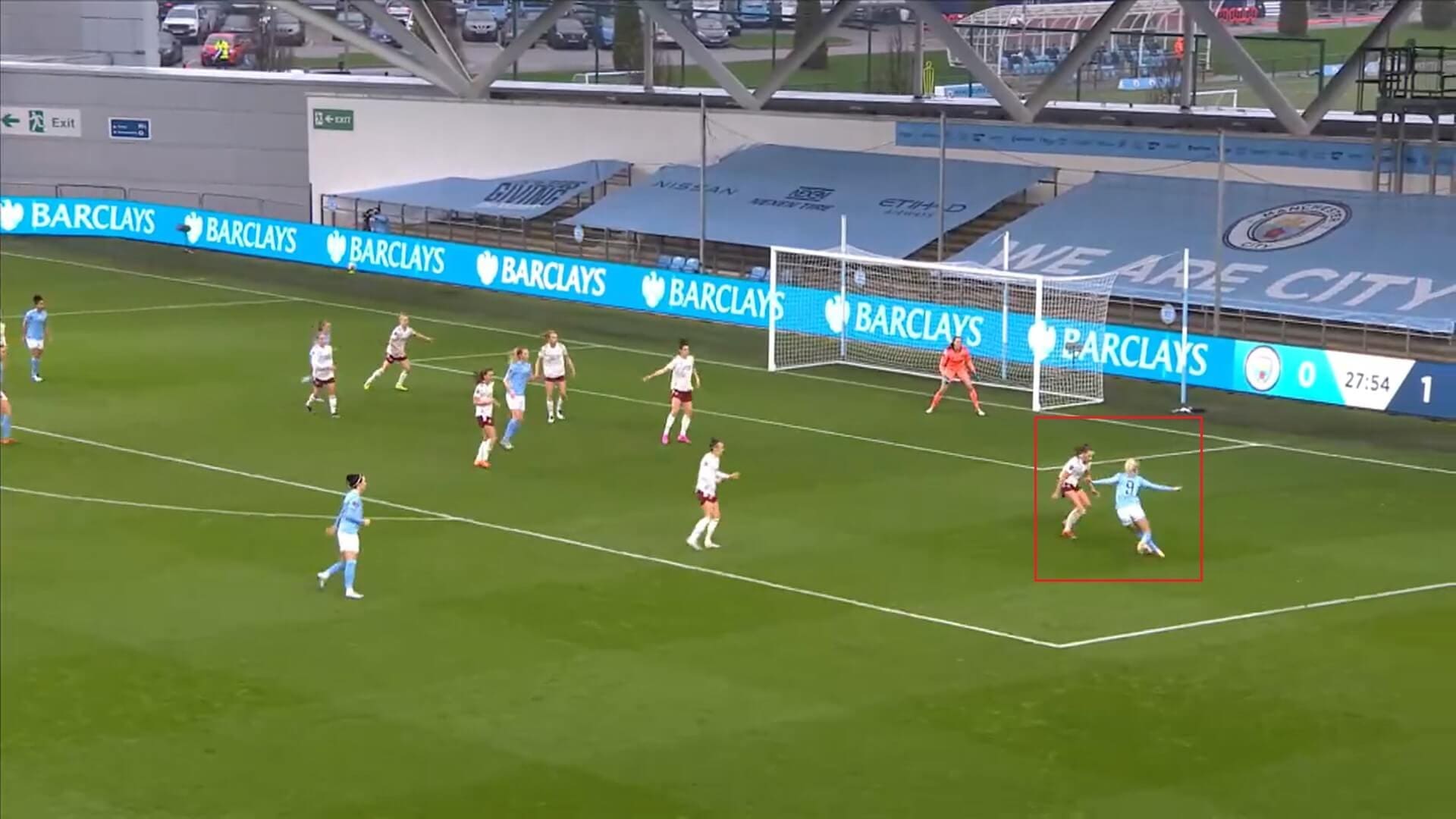
However, it wasn’t just in attack where Arsenal were pressing. We can see in this image how, when defending against Manchester City’s probing attacks, they also gave their opponents as little space as possible. The battle between Arsenal left-back Katie McCabe and Manchester City forward Chloe Kelly was a reoccurring feature of the game, and we can see here how McCabe made sure that Kelly couldn’t find a way into the box. Whilst the Republic of Ireland international was getting tight to Kelly, her teammates were staying further back, ensuring that the central attackers were marked and couldn’t get on the end of any balls that did happen to come into the box. This setup was a constant feature of the game, and, aside from Sam Mewis’ goal from a set piece, Manchester City didn’t pose a threat in the first half as a result.
Manchester City Women’s change in attack
We have looked at how Arsenal Women played high pressing tactics to put pressure on Manchester City Women in possession; now we will develop our analysis of how the home side made changes structurally to give them more freedom in the second half.

Firstly, we will look at the issues they had in the first half. Unlike Arsenal, who were playing as high up the pitch as they could, Manchester City seemed more reluctant to get into good attacking areas. They played with high full-backs, as we can see in this image, but Bronze and Stokes weren’t able to get the ball into dangerous areas, because the passing options weren’t there for them to find. Therefore, Arsenal found it easy to get back and occupy the spaces, forcing Manchester City to then pass the ball backwards, looking for another way through.
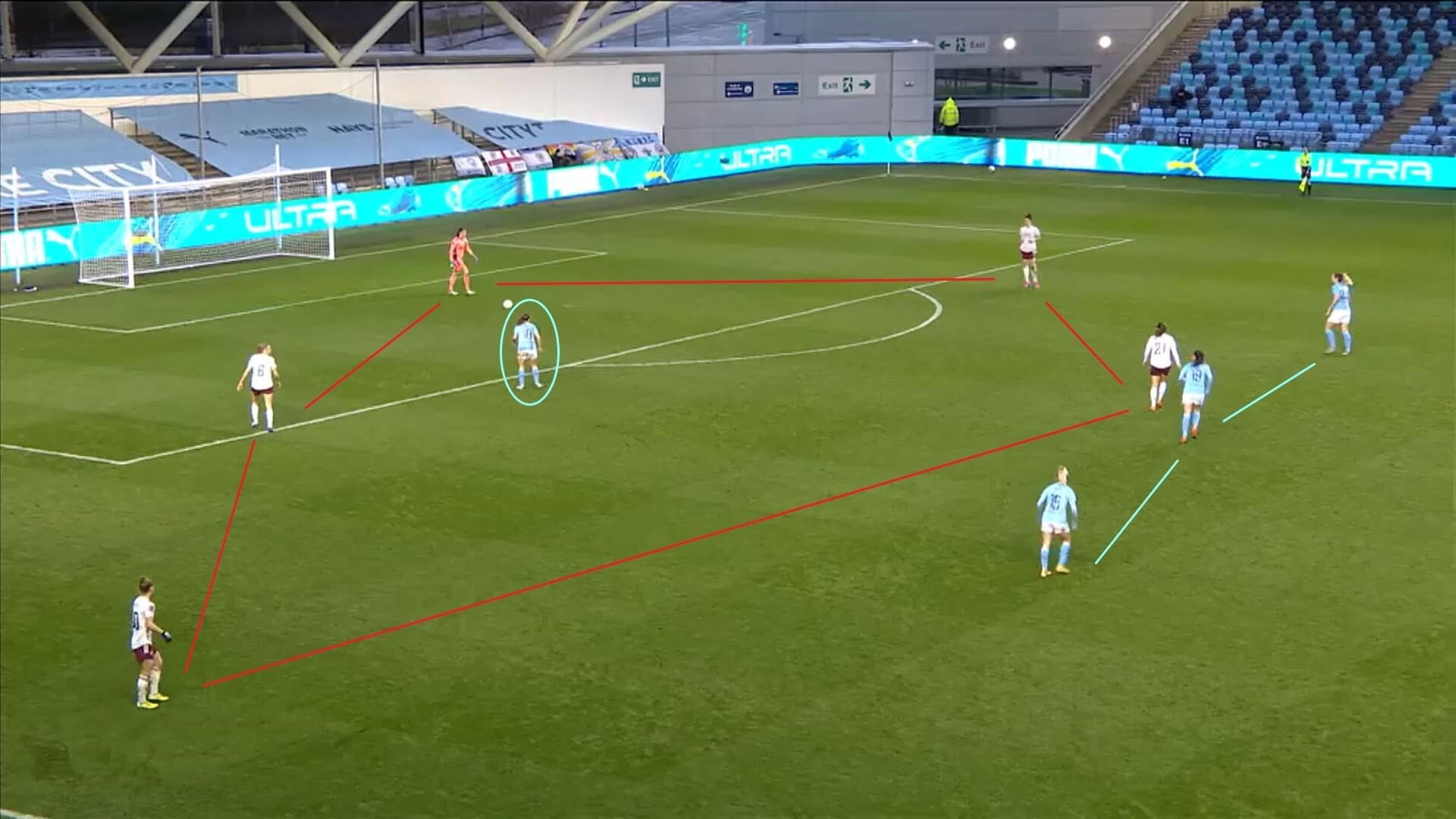
There was also little co-ordination between all the attacking players. Arsenal pressed together, knowing who was running forward each time the ball was passed. However, if we look at Manchester City’s attack, we can see how Georgia Stanway, as the central attacker in this game, was often left alone against the Arsenal backline. The blue lines show the players behind her, and we can see the enormity of the gap between them. Therefore, Arsenal had a lot of space to play in, and were able to easily surround Stanway, as the red lines show. This led to them moving the ball into the spaces and clearing it, as we have already mentioned.
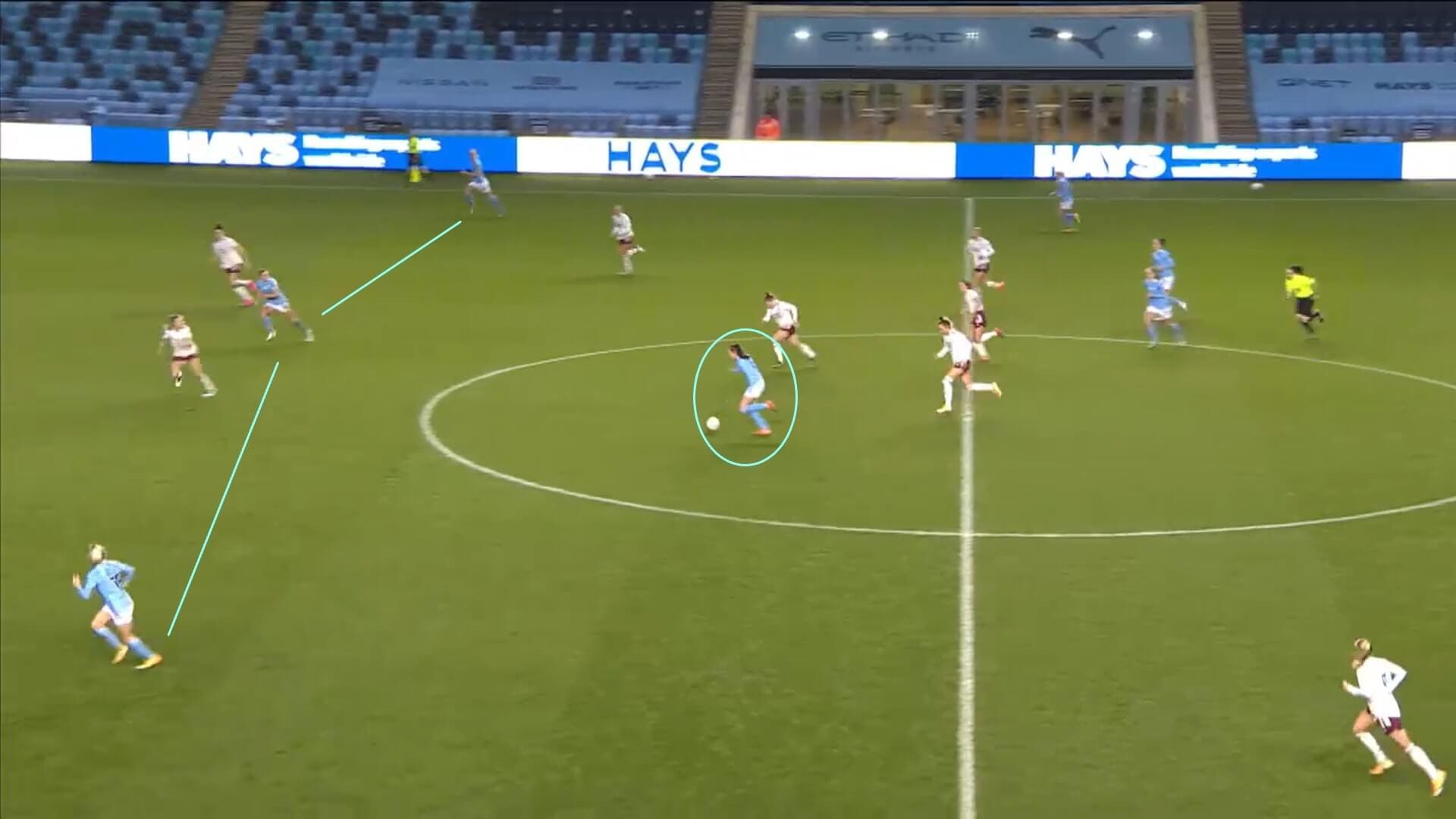
Partway through the second half, Manchester City changed this, getting more players upfront to form an attacking line rather than having a single attacking player. The catalyst for this was the introduction of striker Ellen White, who took over the central line, allowing Stanway to play in her more natural wider role. This gave them better balance, and gave them more threat in the final third, as we can see here; Caroline Weir has the ball, and now has three forward passing options to move it to, instead of just one.
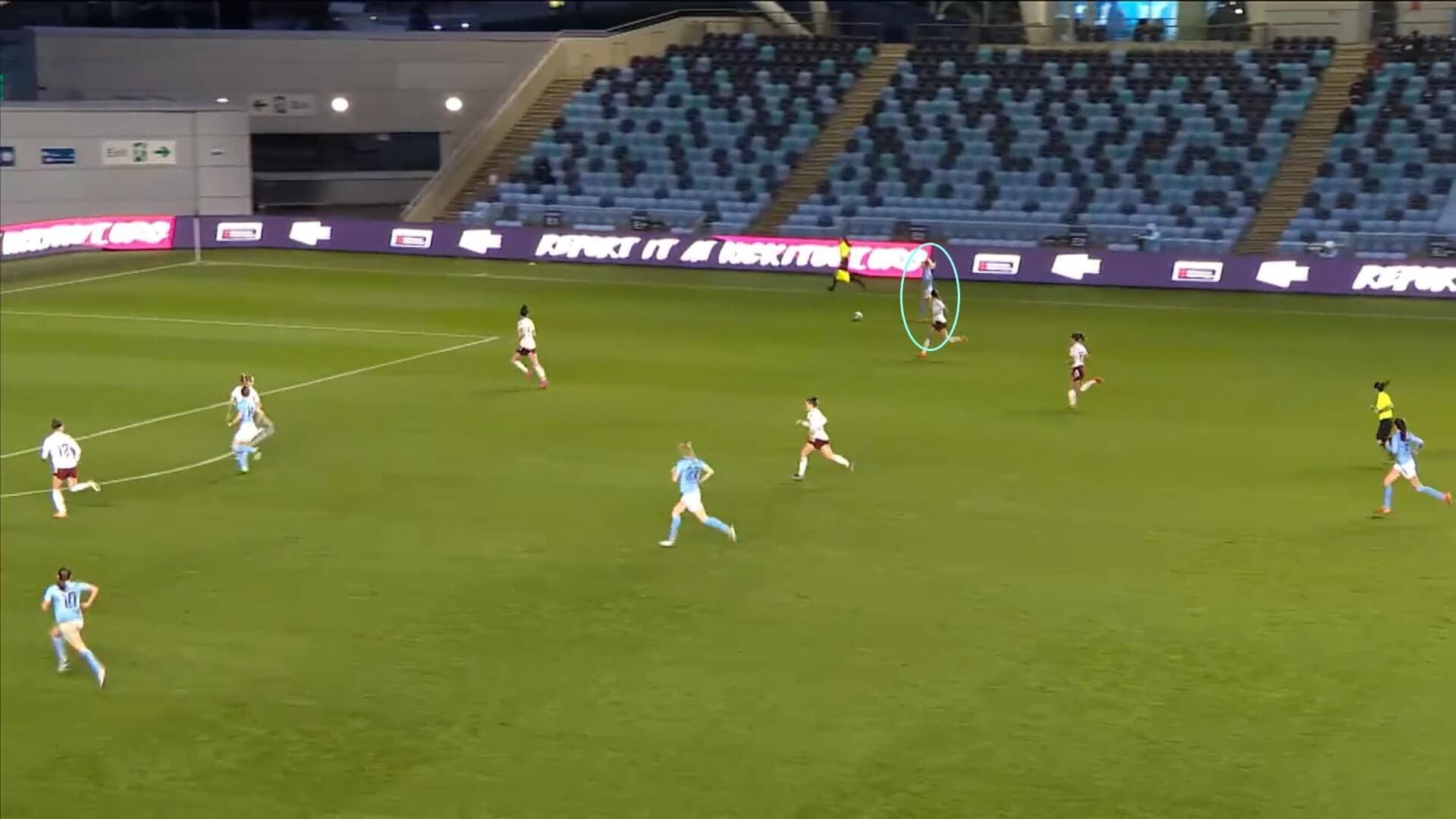
We mentioned at the start of this analysis how Manchester City, on the whole, didn’t look to get behind Arsenal’s backline, making it hard for them to get balls into the spaces behind and create good attacking opportunities.
However, after White’s introduction, she added this missing presence to the attack. We can see in this image how she is the furthest player forwards, looking to run between the Arsenal defenders, offering a crossing option for her teammate.
The tactical changes that Manchester City made were subtle but helped them to take control in the second half. Arsenal were forced to abandon their pressing tactics and instead had to stay further back to plug the gaps that the home side were finding much more. Therefore, these changes were key in helping Manchester City to come back and win the match.
Caroline Weir’s role
However, one player was central to all of Manchester City Women’s attacking play; Scotland midfielder Caroline Weir. We will see in this section how, as well as scoring the winning goal, Weir played a key role in getting into spaces, and in turning the game in their favour after half time.

We mentioned in the last section how Manchester City on the whole didn’t seem to want to run behind the Arsenal defence, but there were times that they did look to unlock the space behind. It was usually either Sam Mewis or Caroline Weir that made these runs, and this image shows an example of Weir doing just this. You can see how, by making this run, Manchester City now have a passing option, which is being taken by the player with the ball. These balls asked questions of the Arsenal defence, which we know has been the shakiest part of their team so far this season, so it begs the question as to why Manchester City didn’t look to make these runs more often to test the defenders.

Again, Manchester City have the ball in a good area and are looking to get it forwards into an area where it can then be moved into the box. Weir spots the space, moving into it to give her teammate the passing option. We know Weir is a good crosser of the ball, so Manchester City will benefit from her having the freedom to make these runs into spaces to help her team out.
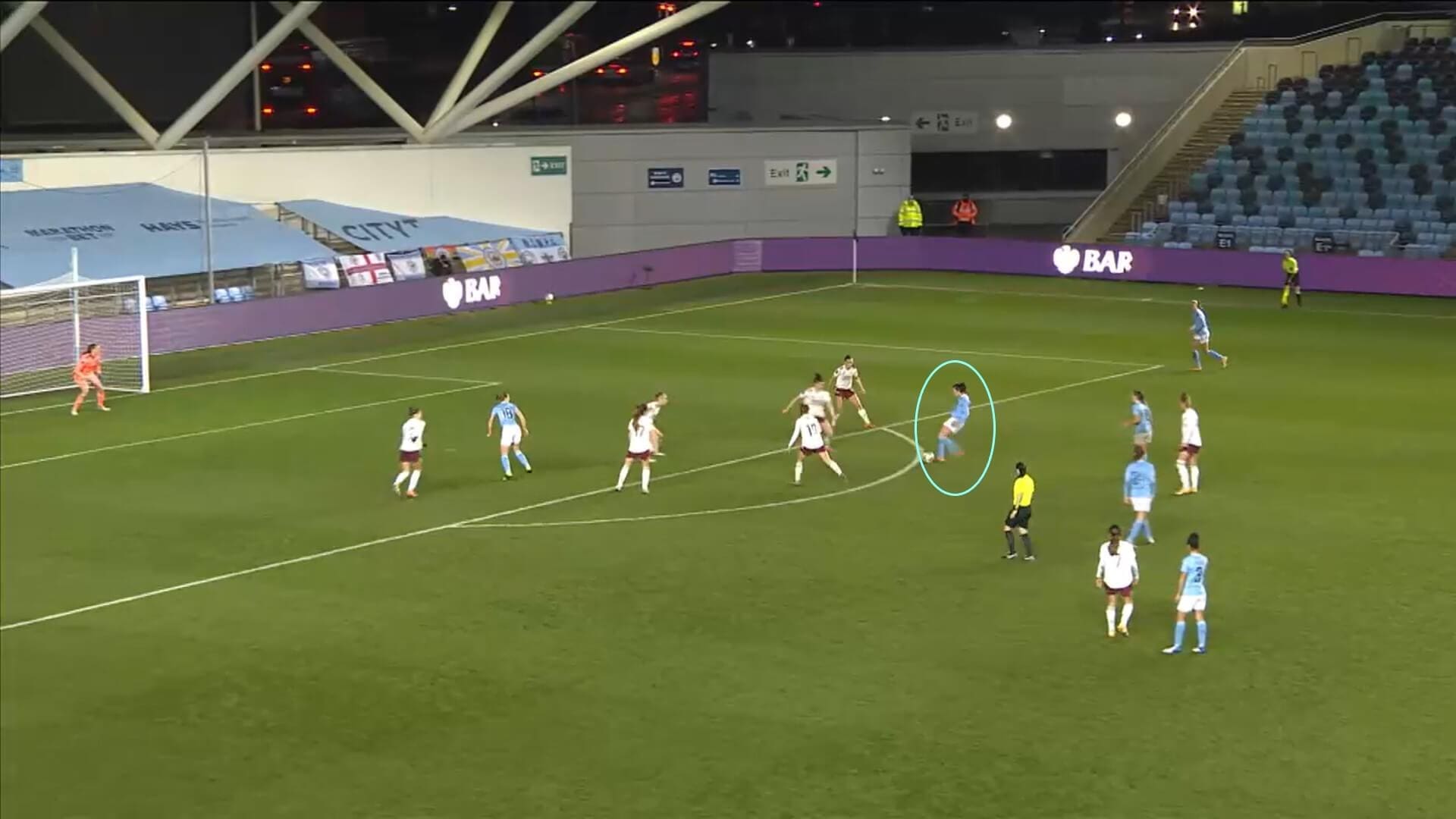
In the second half, Weir found more pockets of space to operate in, and this also helped to increase Manchester City’s threat in the second half. We have seen how they changed their tactics to support the striker much more, and Weir took the role of creative midfielder, linking the play and getting the ball into the forward line, moving it around the pitch and creating opportunities for her team.
This image shows her winning goal, and you can see how Manchester City have got more players forward, but Weir is the one in the space, picking up the loose ball and shooting at goal. She is a player given a lot of freedom by her team, and this allows her to move around the pitch and be wherever Manchester City need an extra player; we have seen how she can operate as a winger, an attacking midfielder, and a central striker in this section, proving this point. Therefore, whilst the forward line changes was a key factor in the win, Weir played a major role in helping her team to be more on the front foot as the game went on.
Conclusion
In conclusion, this tactical analysis has shown how Arsenal Women had control of the game in the first half, with the pressing tactics allowing them to force Manchester City Women into making errors at the back and giving them easy shooting opportunities. It has shown us how Manchester City were flat in the first half, and lacked a goal threat or the same urgency that Arsenal were showing, but then how they made some alterations in the second half to improve this. We have also looked at how Scotland midfielder Caroline Weir, as well as scoring the winning goal, played a key role in her team’s turnaround, finding areas to operate in that helped to link up the play and support the forward line.
Manchester City’s next game sees them travel to Birmingham City Women, in what looks on paper to be a tough game for them against a well-organised side, whilst Arsenal Women also have a tough game at home, hosting an Everton Women team who have impressed so far this season.





Comments